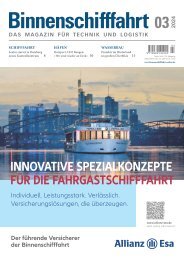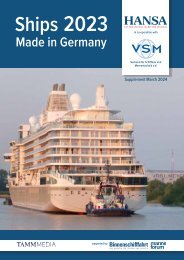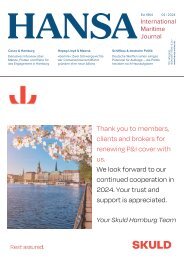HANSA 03-2018
Propeller Performance | Koalitionsvertrag | Jubiläum ZVDS | Robotik im Hafen | Ballastwasser Survey 2018 | Finanz- und Schifffahrtsstandort Nordamerika | Zeaborn & Rickmers
Propeller Performance | Koalitionsvertrag | Jubiläum ZVDS | Robotik im Hafen | Ballastwasser Survey 2018 | Finanz- und Schifffahrtsstandort Nordamerika | Zeaborn & Rickmers
Sie wollen auch ein ePaper? Erhöhen Sie die Reichweite Ihrer Titel.
YUMPU macht aus Druck-PDFs automatisch weboptimierte ePaper, die Google liebt.
Häfen | Ports<br />
nal, Road and Rail Improvement includes<br />
a series of improvements to increase efficiency<br />
and capacity.<br />
According to the port authority, Vancouver<br />
is strategically located as a major<br />
Asia-Pacific gateway and connected to<br />
key markets in North America through<br />
three Class I railways CN, CP and BNSF.<br />
A spokesperson tells <strong>HANSA</strong>, Vancouver<br />
has grown by roughly 30 mill. t in the<br />
last five years. »We expect this to happen<br />
again in the next five years or so.«<br />
In the first six months of 2017 alone,<br />
overall cargo throughput increased by<br />
4% to 69 mill. t with mid-year records<br />
in bulk grain and containers. Container<br />
quantities increased by 9.6% to a record<br />
1.6 mill. TEUs. Strong overseas demand<br />
for Canadian grain products resulted in<br />
a steep increase in wheat, canola and specialty<br />
crop exports, which include pulses<br />
and lentils (up 55%). Bulk cargoes<br />
are of high importance for the port. In<br />
2016 alone, these made up 69% of total<br />
port cargo.<br />
The spokesperson adds that these volumes<br />
are expected to grow at a faster rate<br />
than total cargo at the port. She adds,<br />
»Land is constrained here in the Lower<br />
Mainland and we are doing what we<br />
can to make current port operations as<br />
efficient as possible and advocate for the<br />
preservation of industrial land.«<br />
In Halifax on the East Coast, containerized<br />
cargo growth continues. In 2017 the<br />
volume was 559,242 TEUs, up 16% and up<br />
34% compared to 2016 and 2015 respectively,<br />
according to the port authority. It<br />
is the highest volume for a single year. Total<br />
cargo tonnage through HPA facilities<br />
was 5.01 mill. t, up 12%. Spokesman Lane<br />
Ferguson tells <strong>HANSA</strong>, that the port will<br />
continue to focus on velocity, specifically<br />
working to improve upon dwell and truck<br />
processing times, and moving vessels on<br />
and off the berth without delay. Also on<br />
the agenda are technology improvements<br />
as the port prepares for block chain applications<br />
and working with partners on<br />
further development of feeder hub services<br />
for the New England states.<br />
According to Ferguson, »Halifax is<br />
able to berth and service vessels up to<br />
16,000 TEUs. The South End Container<br />
Terminal has unobstructed ocean access,<br />
16 m depth, 660 m continuous berth,<br />
2,400 m double-stack on-dock rail and<br />
super post-Panamax cranes.«<br />
The port authority is looking at ways<br />
to expand or develop the necessary pier<br />
length required to berth and service two<br />
vessels over 10,000 TEUs/400 m length<br />
overall simultaneously.<br />
The port of Montreal also saw a record<br />
year with growth in all sectors<br />
and a record tonnage of 28 mill. t. As in<br />
past years, the container sector was the<br />
growth engine, with one in four containers<br />
connected to Asia. Overall, container<br />
throughput went up 6%. While the<br />
growth is still attributable to the Asian<br />
market, which is up 17.8%, the African<br />
market rose by 10.3% and the Mediterranean<br />
by 9.2%.<br />
Aspects leading to growth are infrastructure<br />
projects like:<br />
The new Viau container terminal<br />
completed its first year of operation in<br />
2017. The project will bring the total<br />
handling capacity in the Viau sector to<br />
600,000 TEUs.<br />
The port authority is pursuing the<br />
project of a container terminal in Contrecoeur.<br />
When completed, the port capacity<br />
would grow by 1,14 mill. TEUs to<br />
2.1 mill. TEUs. The port authority is heavily<br />
working on obtaining the permits to<br />
realize this project.<br />
The growth perspective is expected<br />
to continue in <strong>2018</strong>, given that CETA<br />
came into effect on a preliminary basis<br />
in September 2017 and the rebound<br />
of the American economy is expected<br />
to continue at a moderate pace. In fact,<br />
although the Panama Canal expansion<br />
could favour the port’s container sector,<br />
the main growth engine will still come<br />
from transhipment with emerging markets<br />
through the Suez Canal, the spokesperson<br />
thinks. At the same time she is<br />
seeing a lot more cargo coming from<br />
Asia. Given that renegotiations of the<br />
Free Trade Agreement (NAFTA) are<br />
still underway, the port did not want to<br />
comment on this. »The U.S. Midwest has<br />
always been a big market for Montreal,<br />
mainly thanks to our proximity to Europe<br />
and our location 1,600 km inland.<br />
But since this portion involves international<br />
trade, it is not affected by NAF-<br />
TA,« it is explained.<br />
M<br />
The St. Lawrence Seaway is an important factor<br />
both for the Canadian and the U.S. port industry<br />
Photo: USCG<br />
<strong>HANSA</strong> International Maritime Journal – 155. Jahrgang – <strong>2018</strong> – Nr. 3 83


















